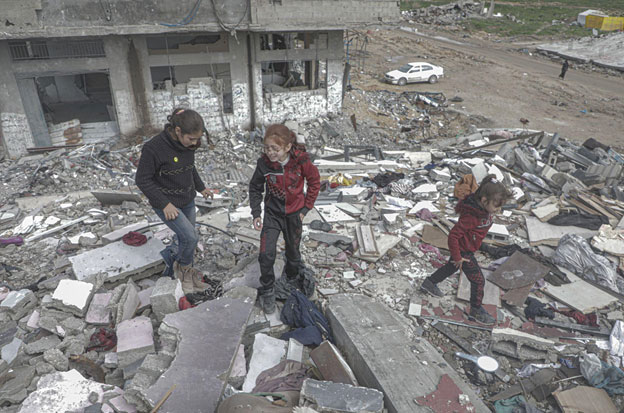UNITED NATIONS, Apr 21 (IPS) – Since the deterioration of the ceasefire agreement between Israel and Hamas in March, the Israeli Defense Forces (IDF) have issued numerous evacuation orders and bombardments on the Gaza Strip, resulting in exacerbated rates of displacement and a significant amount of civilian casualties. Roughly two million Palestinians within the enclave struggle to stay alive amid repeated blockages of humanitarian aid.
Approximately one month after Israeli authorities called off the ceasefire, negotiations for the cessation of hostilities resumed once more between Israel and Hamas. A spokesperson for Hamas informed reporters that Israeli authorities had presented a proposal for a six week ceasefire, which would entail the release of ten Israeli hostages in return for hundreds of Palestinian refugees and prisoners.
Additionally, the proposal did not specify if the ceasefire would be permanent and called for a complete disarmament of Gaza. On April 15, a spokesperson for Hamas confirmed that the ceasefire proposal had been rejected.
On April 15, the Office for the Coordination of Humanitarian Affairs (OCHA) issued an update on the current humanitarian situation in the Gaza Strip. OCHA states that due to repeated evacuation orders, blockades on humanitarian aid, and intensifying bombardment, Gaza is currently going through the worst phase of this crisis since October 2023. This Monday marks 50 days since Israeli forces started blocking aid trucks into Gaza.
According to figures from the Site Management Cluster (SMC), roughly 401,000 Palestinians are estimated to have been internally displaced as a result of the recent hostilities. Estimates from the United Nations Relief and Works Agency for Palestinian Refugees (UNRWA), there have been at least 20 evacuation orders issued by the IDF in the past month alone, spanning over 142.7 square kilometers of the enclave.
Over 69 percent of Gaza has been declared as “no-go zones”. On April 16, Israel’s Defense Minister, Israel Katz, issued a statement to X (formerly known as Twitter), indicating that Israeli troops will remain in “security zones” in Gaza indefinitely and will annex land in the enclave to act as a “buffer” between Israeli communities and enemy lines, similar to Lebanon and Syria.
In the past four weeks, the IDF has escalated its bombardment across Gaza, resulting in hundreds of civilian casualties. On April 9, OCHA confirmed that dozens of civilians, including at least eight children, were killed following an airstrike on a residential building in Gaza City.
On April 14, the World Health Organization (WHO) confirmed that the IDF had conducted an airstrike on the Al Ahli Hospital, rendering the facility “out of service”. This attack also resulted in the death of a child patient with head trauma who was being evacuated out of the hospital. Roughly 40 patients in the hospital remain in critical condition and cannot be evacuated. An additional 50 patients have been evacuated to receive care at other medical facilities.
According to a press release from the Office of the United Nations High Commissioner for Human Rights (OHCHR), this attack follows approximately 670 previous attacks on medical facilities in Gaza. Since October 2023, 122 health facilities have been affected and 33 hospitals have been damaged from Israeli bombardment and lootings.
“With this latest attack on the health system, the options for health care – especially emergency care – for the people of Gaza are reduced to zero, and Israel continues to operate with impunity,” said Tlaleng Mofokeng, the United Nations (UN) Special Rapporteur on the right to health. “Health care facilities and health workers must be protected under international law.” Mofokeng added that the healthcare system in Gaza has been further damaged due to continued harassment and intimidation toward primary responders.
Since March 2, the IDF has halted all deliveries of humanitarian aid, essentially forcing the Palestinians within the Gaza Strip to rely on the remaining resources from previous aid missions for survival. As supplies dwindle, thousands have experienced the effects of food and water insecurity and disease.
According to figures from OCHA, over 90 percent of households in Gaza have reported water insecurity. Roughly 50 percent of water, sanitation, and hygiene (WASH) facilities, equal to 320, have been impacted by repeated evacuation orders and the introduction of no-go zones. Approximately 320 WASH facilities
Additionally, Gaza is dealing with widespread food insecurity once more following the minor improvements during the ceasefire. Roughly 3,700 children have been recorded showing signs of acute malnutrition in March alone, marking nearly a two-fold increase from the previous month. Furthermore, the number of children in Gaza receiving supplemental nutritional care has decreased by 70 percent since February.
“Mass casualty events are now the norm and those hospitals that are treating trauma patients are doing so amid severe shortages of critical supplies, including critical medicine,” said Olga Cherevko, a staff member from OCHA. “Supplies that we had are rapidly running out and we’re running out of food, medicine, shelter and every other life-critical item if the situation does not change immediately. The catastrophe that is in Gaza will become worse and the needs of the people will become even higher. This cannot continue. Civilians must be protected and the crossings must be reopened immediately.”




